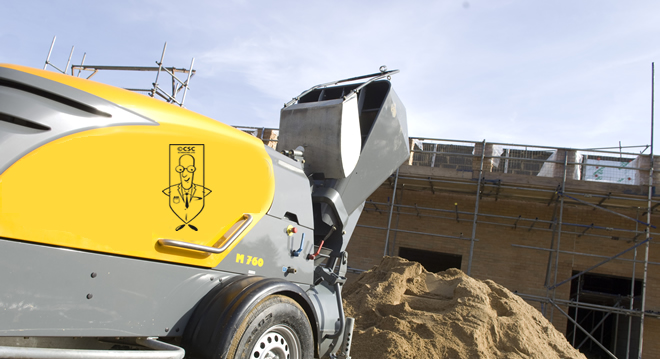 Follow this procedure:
Follow this procedure:
- Visually inspect the screed pump for obvious faults.
- Check the engine oil by using the dip stick.
- Check the compressor oil whilst the engine is cold.
- Check the hydraulic oil by viewing the gauge whilst the engine is cold.
- Check the automatic grease lubrication bellow and top up as necessary.
- Check the mixing blades.
- Check the wear plates.
- Check the air intake in the neck of the mixing pot is clean.
- Check the vessel outlet is free of obstruction.
- Check the seal of the vessel lid and make sure it sits tight on the vessel pot when closed.
- Check the lid locks down correctly and is not worn.
- Check the air relief valve opens and closes.
- Check the air outlet pipe is clear and free of obstruction. The outlet should be full diameter to allow volume of air to pass through.
- Check the cam lever locks on the outlet pipe is properly closed.
- Ensure the mixing blades are switched to neutral.
- Engage the ignition switch and press the start button. Hold the start button in until fully running.
- Engage the mixing blades and check the safety grill works.
- Connect the screed pipes to the required location and add the tripod. Ensure safety pins are used and the pipes are visually inspected for imperfections. Any defective looking pipes should not be used and reported to the CSC manager at the office.
- Secure the pipes at regular intervals to restrain and ensure the safety of others.
- All checks are now complete with the screed pump and lines.
- Complete a daily / weekly screed pump inspection form
- Report any defects immediately and refrain from using the machine.

Emergency stop procedure
- Hit emergency stop button or switch off engine.
- Release air pressure to stop any flow of screed.
- Disengage blades.
- Switch pump to neutral.
Start the mixing process
- Connect the water supply and run a hose to your water butt.
- Fill your water butt.
- Part fill, circa 25% of a 5 litre bucket.
- Add a handful of fibres to the 5 litre bucket to allow adequate dispersion.
- If using FlexiDry, add the correct dosage to the 5 litre bucket and allow dispersion.
- Check the screed operative is ready to start receiving the screed and at the ready with the tripod.
- Ensure communication is enabled to start, stop, adjust the mix, emergency stop, etc.
- Start the screed pump and engage the mixing blades.
- Load 50% of the sand.
- Add all cement.
- Add all the contents of the 5 litre bucket (water, fibres and FlexiDry).
- Add 100% of any single sized aggregate if required.
- Load the other 50% of the sand.
- Add further water if required to get the desired consistency.
- Close the vessel lid and lock into place.
- Close the air relief valve and engage the pump switch to send the material.
- Prepare the 5 litre bucket with water, fibres and FlexiDry in readiness for the next mix.
- Observe the pressure gauge to ensure the material is being delivered.
- Good pumping pressure is around 5 bar.
- Once the pressure comes back down to maybe 1 bar, switch the pump to neutral, release the pressure relief valve to empty the system of any compressed air, open the lid and start refilling the mix.
- Repeat as necessary.
Clearing a blockage in a Screed Pipe
- A blockage will become evident as the pressure builds up on the gauge and the screed pipe will stop moving.
- The line should be walked to determine the location. Walk on the pipe until it becomes soft. This is the location of the blockage.
- Disengage the sending switch, release all the compressed air with the air relief valve.
- Switch the machine off and disengage the blades.
- Disconnect the screed pipe at the desired location and shake the pipe to remove the blockage. Be careful of any pressurised air pockets in the pipe. Extra precaution to eyes should be established. A stubborn blockage may require some shaking and banging. Do not look up a pipe!!
- Once removed, reconnect the pipe and safety pin.
- Switch the engine on, close the relief valve, engage the blades and switch the send button.
- Monitor the pressure gauge to confirm delivery.
Clearing a Blockage in the mixing vessel
- A blockage will become evident as the pressure will build up on the pressure gauge and the screed pipe will stop moving.
- The line should be walked to determine the location. If the screed pipe is soft at the outlet of the vessel, we know its a blockage in the mixing vessel.
- Disengage the sending switch, release all the compressed air with the air relief valve.
- Switch the machine off and disengage the blades.
- Disconnect the screed pipe at the outlet location.
- Check the screed pipe for a blockage. If clear, its obvious the blockage is in the outlet within the vessel.
- Remove the safety grill to access the mixing vessel.
- Dig away the screed to gain access down to the outlet from the inside. An obstruction may now be found. Use a narrow bar and place it in the outlet from the inside. Push the obstruction back into the cleared mixing vessel and remove.
- Connect the safety grill back into place.
- Reconnect the pipe and safety pin.
- Switch the engine on, close the relief valve, engage the blades and switch the send button.
- Monitor the pressure gauge to confirm delivery.
Washing the screed pump
- Place the discharge tripod with the screed pipe still connected into a skip or designated wash out facility.
- Place a protective polythene layer around the tripod to contain water and grout splashing when its discharged.
- Fill the mixing vessel with water whilst it’s running and leave the blades turning.
- Once its full, you can now discharge the water. Ensure that somebody is holding the tripod whilst discharging.
- The pump can now be switched off, blades disengaged, air relief valve opened to ensure any compressed air is released.
- Remove the screed pipe at the outlet.
- Remove the safety grill and flush out the vessel.
- Thoroughly wash the whole screed pump externally and scrub all areas to remove screed contamination.
- The machine is now ready for the next use.
Correct method of rolling up screed pipes
- Ensure that you have plenty of rope handy.
- Tie a loop in the rope to assist in tying the pipe.
- Straighten out the screed pipe in readiness for rolling up.
- Make the first roll and tie the joint to the pipe.
- Continue to roll the pipe to ensure a neat and tidy manageable size.
- Tie the other joint to the rest of the pipe with a further piece of rope.
- The pipe is now ready to transport from site.






